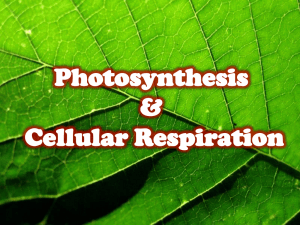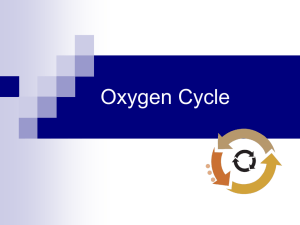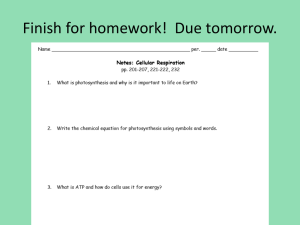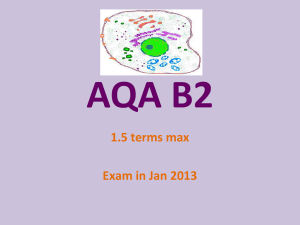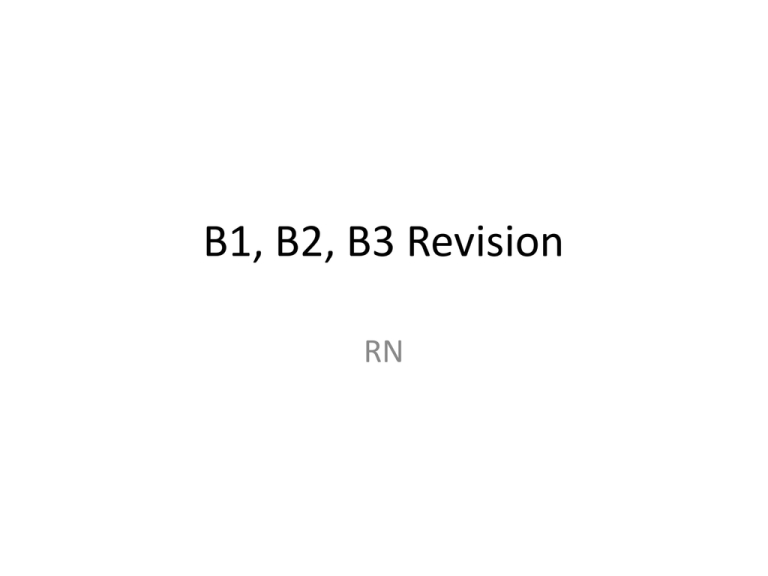
B1, B2, B3 Revision
RN
R.Narasimhan
BP: measured in mmHg
Systolic pressure: maximum pressure the heart produces
Diastolic pressure: blood pressure between heart beats
Aerobic respiration:
Glucose + oxygen Carbon dioxide + water + energy
Exercise creates an oxygen debt
Anaerobic respiration:
Glucose Lactic acid + energy
•Much less energy released than aerobic respiration
•You breathe heavily to replace oxygen
•Heart beats faster so blood carries lactic acid away to liver to be broken down
Measuring fitness:
Strength, flexibility, stamina, agility, speed
BMI= mass (Kg)
height (m)2
RDA: Recommended daily allowance
Types of cancer:
Benign tumours are slow to divide, harmless and do not spread
Malignant tumours are cancerous, divide out of control and spread throughout the
body
Carbohydrase (produced in the mouth,
pancreas and small intestine) breaks
_______ (a carbohydrate) down into
glucose:
Protease (produced in the stomach,
pancreas and small intestine) breaks
_______ down into amino acids:
Lipase (produced in the pancreas and small
intestine) breaks fats (_____) down into
fatty acids and glycerol:
Words – blood, lipids, proteins, digestion, starch, smaller
RDA(g) = 0.75X body mass (Kg)
Protein deficiency - Kwashiorkor
Inheritance- Parents who are both carriers of
the Cystic fibrosis allele (c).
Parents
Cc
x
Cc
Gametes
C or c
x
C or c
(egg/sperm)
C
c
Possible Outcomes
C
CC
Cc
75% Normal
c
Cc
cc
25% sufferers
Cystic Fibrosis
Caused by recessive allele (so two
copies of allele are needed).
A thick sticky mucus is produced
affecting air passages and
digestive systems
Controlling Blood Sugar
Controlled by the pancreas, diabetics
do not produce enough insulin
Treatments
Injections or monitoring diet
Producing antibodies
Step 1: The lymphocyte “sees”
the pathogen (microbe
)
Glucose
rises (eat
food)
Normal
blood
glucose
level
Glucose
falls
(exercise)
Insulin produced
by the pancreas
causes glucose to
change to
glycogen
Glucagon released
and glycogen
converted back to
glucose
Normal
blood
glucose
level.
Step 2: The cell produces antibodies
Temperature
to “fit” the pathogen
Monitored by
thermoregulatory
centre in brain and
receptors in skin.
Too Hot
-hair lies flat
Step 4: The pathogens are
Step 3: The antibodies fit onto
the pathogens and cause them to “eaten” by the white blood cells
“clump”
Reflex action: Stimulus receptor sensory neurone
relay neuron in spinal cord motor neurone response
Concave lens and convex lens corrects refraction of light rays
so the image lands on the retina
-blood vessels
dilate so heat lost
through skin
-sweat produced
Too Cold
-goosebumps &
hairs trap air
-blood vessels
constrict
-no sweat
-shiver, respiration
releases heat
Class A
Class B
Class C
Example
Ecstasy, LSD, heroin,
cocaine, crack, magic
mushrooms,
amphetamines (if
prepared for injection).
Amphetamines, Cannabis,
Methylphenidate
(Ritalin), Pholcodine.
Tranquilisers, some
painkillers, Gamma
hydroxybutyrate (GHB),
Ketamine.
Possession
Up to seven years in
prison or an unlimited
fine or both.
Up to five years in prison
or an unlimited fine or
both.
Up to two years in prison
or an unlimited fine or
both.
Dealing
Up to life in prison or an
unlimited fine or both.
Up to 14 years in prison
or an unlimited fine or
both.
Up to 14 years in prison
or an unlimited fine or
both.
DNA with bases
Damaged cilia in a smoker’s air way
Hormones of the menstrual cycle
Lobed ears are dominant over ears with no lobes
Vasoconstriction and Vasodilation
Human male chromosomes
EVIDENCE OF EVOLUTION
What evidence is there that evolution is
happening?
Fossil record is incomplete because:
•Some body part decay quickly
•Fossilisation is rare
•There may still be fossils we have not
found
HUMAN EVOLUTION
NATURAL SELECTION
D______ proposed the theory of
e______ to explain how species change
over time. There is v_______ between
individuals, those that are better
a_______ are more likely to s________
and r________, passing on favorable
characteristics.
How are human beings different
from apes?
• bigger b_____
• w_____ upright
NATURAL ECOSYSTEM
Ocean, dessert, grass land,
rain forest
ARTIFICIAL ECOSYSTEM
Farm land, Aquarium, green house
The up and down pattern of predator and prey
population is called cyclic fluctuations
Photosynthesis happens only during day but
respiration happens both during day and night
LAMARCK
Believed that
acquired
characteristics
can be inherited
The presence or absence of an indicator species is
used to estimate levels of pollution Example: Lichens
CHARLES DARWIN: Developed theory of
natural selection based on survival of fittest
•Genes pass on the successful characteristics to
the next generation
COMPETITION
What resources are plants and
animals in competition for?
• Space
• Food
• Mate
Invertebrate
Vertebrate
No back bone
Example: Worms,
insects
Back bone present
Example: Humans,
fishes
EXTINCTION
Causes of extinction:
• increased c_______
• New p________
• e_________ change
• new d_________
Sustainable development
is taking things from the
environment but leaving
enough behind to
ensure a supply for
the future and
prevent damage
PHOTOSYNTHESIS : Carbon dioxide + water ------ glucose + oxygen
LINCOLN INDEX: Population =
Number of animals
number of animals
Caught 1st time
X caught 2nd time
number of marked animals caught second time
MUTUALISM: When both
Organisms benefit, example:
Pea plant and
nitrogen – fixing bacteria
Adaptation: features which help a plant
or animal survive in an extreme
environment,. Example: Polar bear, Camel and
cactus
Vertebrate group
Description
Fish
Has scales and gills
Amphibian
Has moist permeable
skin
Reptile
Has dry scaly skin
Bird
Has feathers and a beak
Mammals
Has fur and feeds young
on milk
“Species” means “a group of similar organisms”
which are capable of interbreeding to produce
fertile offspring, e.g. dogs
Hybrids:
Hybrids are the result of breeding two
animals form different species, they
cannot reproduce and are sterile.
Example: Tiger +Lion = Tigon
+
Reproduction between species
=
Labrador
Poodle
Labradoodle
Classifying organisms
Mule
Liger
Zebroid
Organism
Geep
Used as energy
Used to make cellulose
for plant cell walls
Used to make plant proteins
for plant growth
Plants
Stored as starch
Stored as fats and oils
Animals
Have
backbone
No
backbone
Vertebrates
Invertebrates
glucose
Photosynthesis
Amphibians
Oxygen
Used in respiration
Direct products of photosynthesis
Released into air
Birds
Reptiles
Fish
Mammals
Ecological niche: The role of an organism in an ecosystem is called its ecological niche.
Example: Native red and American grey squirrels. In Britain, there are 2 types of
squirrels which occupy same ecological niche and there is a competition leading to
decline in number of red squirrels.
Cytoplasm: chemical reactions take place
Cell membrane: Controls movement into and out of the cell
Nucleus: contains genetic information
Mitochondria: Respiration takes place providing energy
Protein synthesis:
Each gene codes for
a particular protein
Nitrogen bases:
Adenine pairs with Thymine
Guanine pairs with cytosine
DNA is a double helix
Genetic instructions are in the
form of a code made up of 4 bases
B3 Living and growing
Haemoglobin + oxygen Oxyhaemoglobin
Platelets: are tiny pieces of cell, which have no nucleus. Important for clotting
Plasma: straw coloured liquid which transports carbon dioxide, glucose, waste products, hormones and antibodies
White blood cells: protect body against disease
Red blood cells: transport oxygen from lungs to the tissues, disc shaped and no nucleus
1)
2)
3)
Enzymes –biological catalysts
that speed up reactions
e.g. respiration in the
mitochondria
Enzymes have an optimum
temperature and pH.
Changes in pH/temp can
denature the enzyme so its
shape changes and the
substrate can’t bind to the
active site
Uses of Enzymes
-Biological washing powders
-In baby foods
-In slimming foods- fructose is
made using isomerases.
Fructose is sweeter than
glucose so less is needed.
1) Enzyme and substrate
2)Substrate binds to active site
3) Substrate is broken down
Heart pumps blood around the body
Arteries transport blood away from the heart
Veins transport blood into the heart
Capillaries exchange materials with tissues
Enzymes and digestion
Large molecules are broken down so they
can be absorbed.
-Amylase breaks down starch into sugars in
the mouth and small intestine.
-Proteases breakdown proteins into amino
acids in the stomach and small intestine.
-Lipases breakdown fats into fatty acids and
glycerol in the small intestine.
Mitosis-used for
normal cell
growth
1) Parent cell
2) Chromosomes make
identical copies
of themselves
3)They line up along
the centre
4) They move apart
5)Two daughter cells
form each with
46 identical
chromosomes to
the parent cell
Meiosis –used to
make the sex
cells (gametes)
-the chromosomes
are copied
-cell divides twice
to give four cells
Used in lungs O2 diffuses into the
blood and CO2 diffuses into lungs
Cytoplasm
Chloroplast
Vacuole
Nucleus
Photosynthesis
Cell Membrane
Cell Wall
Carbon dioxide + Water
Glucose + Oxygen
Light and chlorophyll are
also needed
Cell growth
Cell division
3 Limiting factors -light
-temperature
-CO2
Cell expansion
At first as CO2
increases so does photosynthesis
but only up to a certain point
Here light or temperature is the
limiting factor.
Cell differentiation





